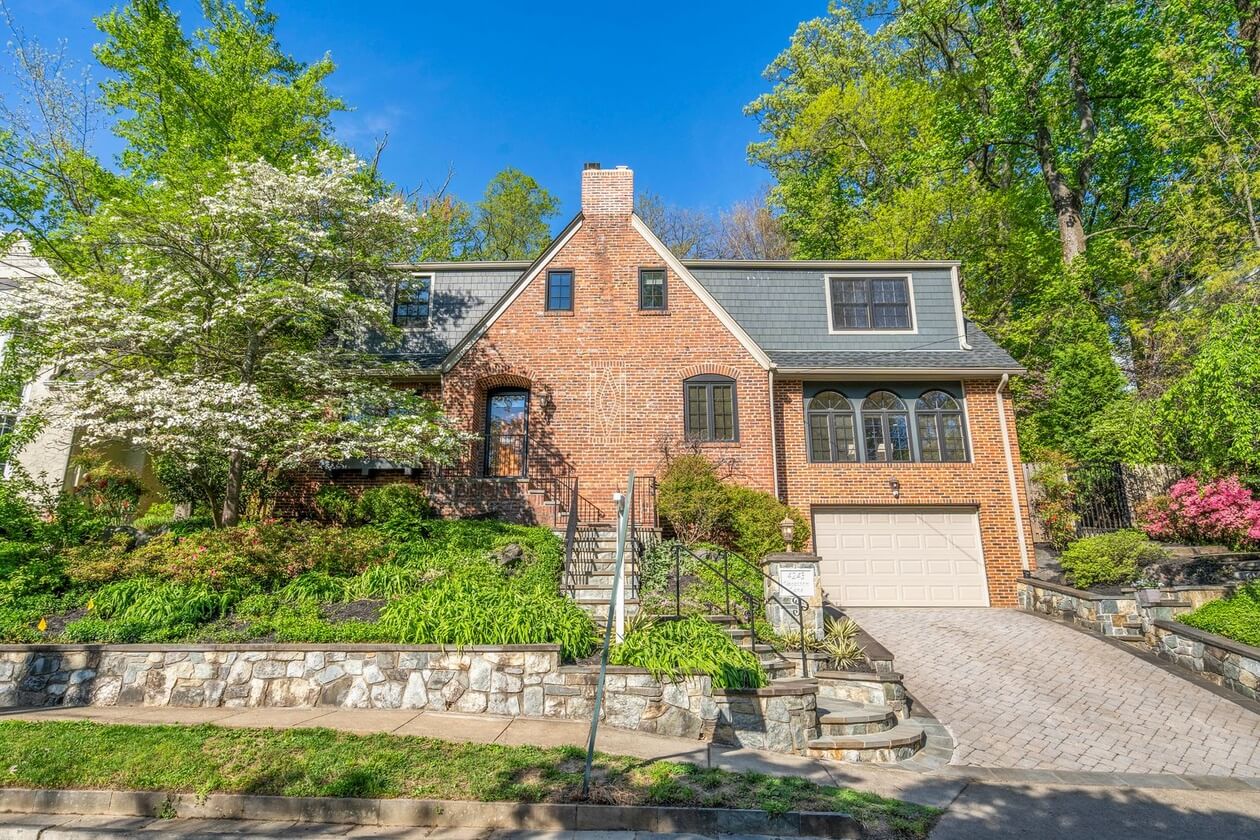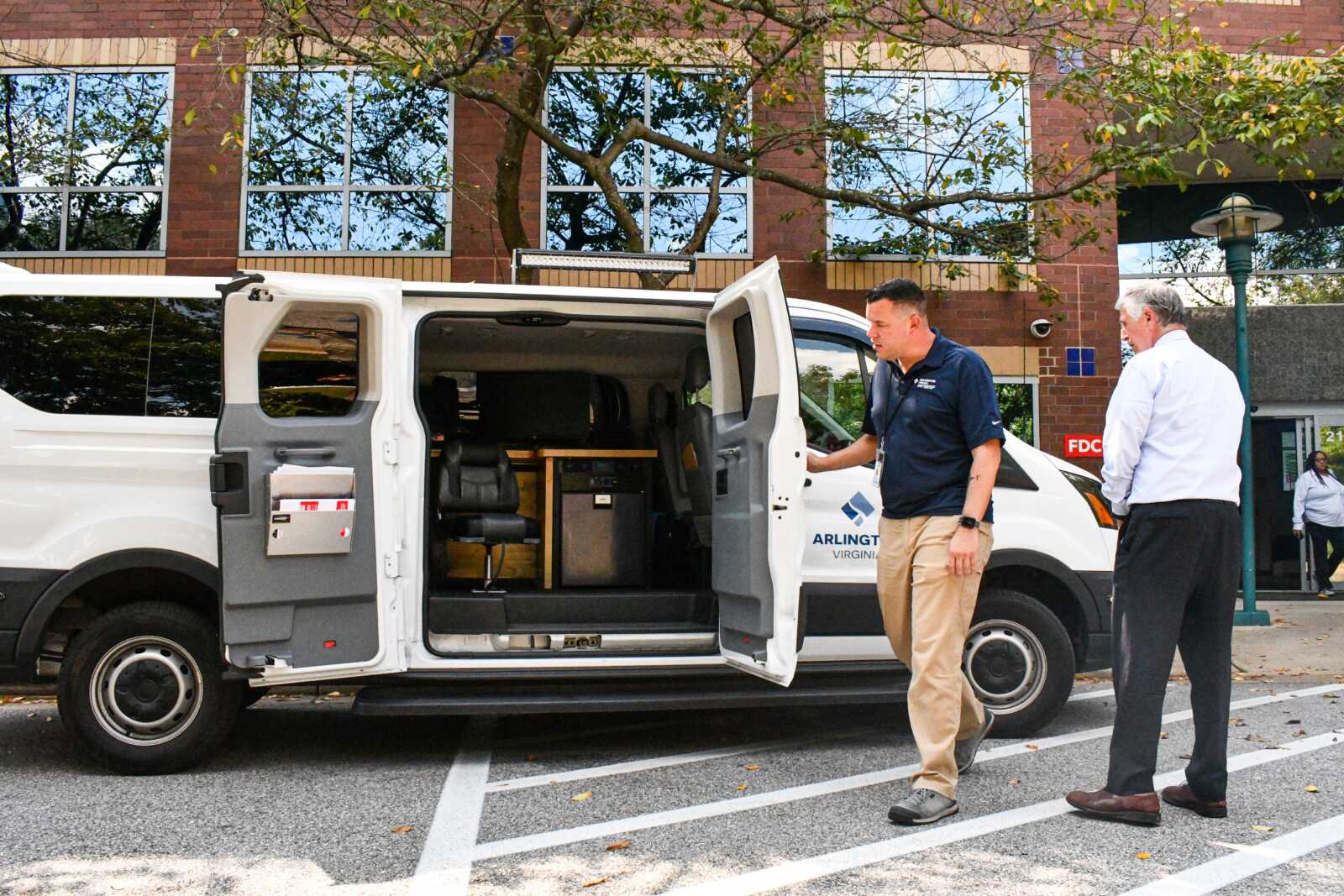(Updated at 4:35 p.m.) The Arlington County Board is eyeing December for a vote on residential zoning changes suggested by the county’s Missing Middle Housing Study.
But changes to the study’s draft framework — for allowing multi-family homes with up to 8 units on properties currently zoned only for single family homes — seem likely.
The Board discussed the often-contentious community feedback to the proposal and possible modifications at a work session Tuesday afternoon. As they talked with county staff and amongst themselves, residents — many with signs supporting or opposing the proposal — packed the Board room and watched with interest.
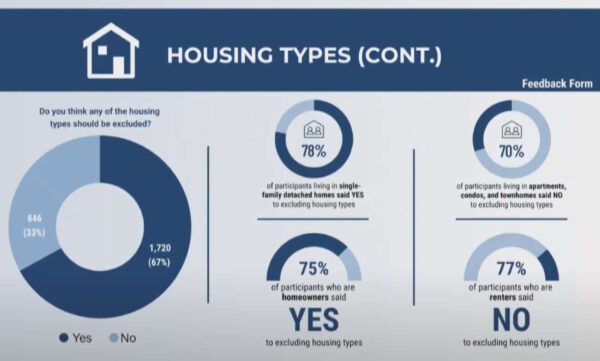
The feedback, county staff said in a presentation, has been mixed but more negative than positive. Of note is the split between feedback from residents of single-family detached homes and those who live in apartments, condos and townhouses.
Asked whether any housing types, from townhouses to 8-plexes, should be removed from the proposal, 78% of single-family detached home residents who provided feedback said yes, indicating opposition to the current proposal, while 70% of those who live in other housing types said no, indicating support.
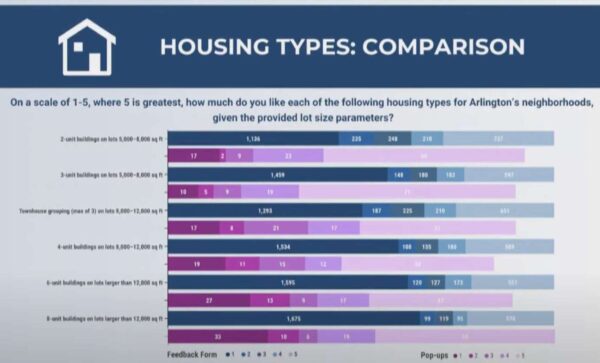
Arlington has about 29,000 single-family detached homes and 79,000 townhouses, apartments, condos and other housing types, the staff presentation said.
Though critics of the missing middle proposal have been calling for more public outreach and feedback, county staff argued that they conducted extensive outreach, including 150,000 postcards, nine pop-up events, six walking tours and an online feedback form.
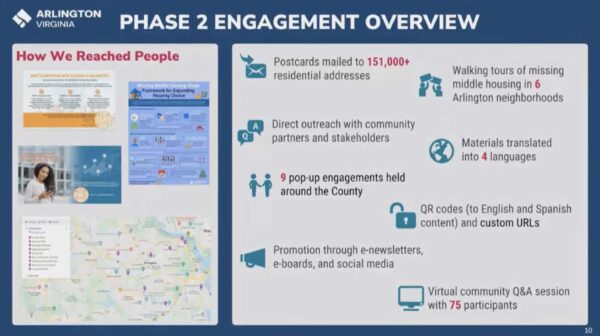
The online feedback form received 2.5 times as many negative comments as positive comments, the staff presentation said, though feedback at the pop-up events and through emails and letters was more positive, with roughly 2.5 times more positive comments as negative via email.
County staff noted that the vast majority of those responding to the feedback form said they own a single-family detached home and reported “white” or “prefer not to respond” under “race and ethnicity.”
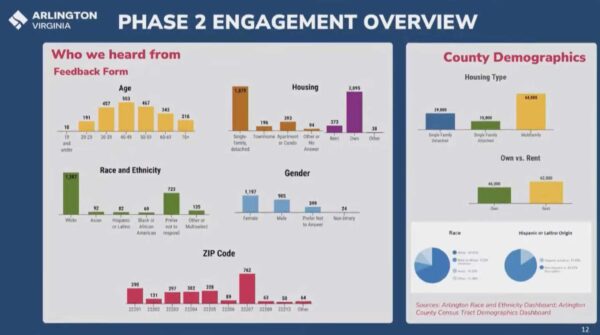
Given the overrepresentation of white homeowners in providing online feedback, staff said they used the county’s “equity lens” and decided to hold pop-up events in areas with renters and minority residents, so as to gather more feedback from those groups.
All told, staff told the Board that it has received “strong” interest and extensive input from the community about the proposal.
“The feedback was fast and furious and ongoing,” said Dept. of Community Planning, Housing and Development Communications Manager Erika Moore.
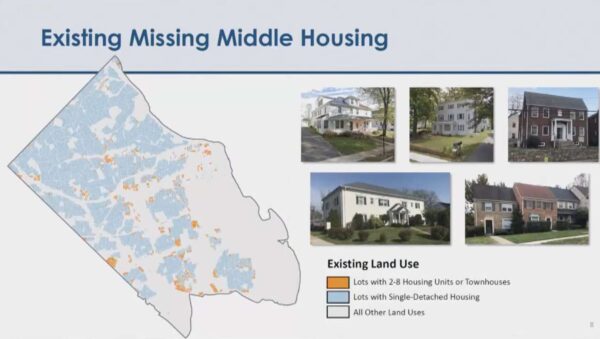
Following the staff presentation, the Board discussed aspects of the proposal and posed questions to staff.
Board members Libby Garvey and Matt de Ferranti — who is up for reelection in November — both expressed concern about putting eight housing units in the footprint of a single-family home in an otherwise single-family home neighborhood.
“The eight units makes me kind of uncomfortable,” Garvey said
“I share the concern with the 8-units for this specific reason, I think it will result in more small half bedroom units,” de Ferranti agreed, joining other Board members in expressing support for “missing middle” homes with more bedrooms, which could house a family.
There was also discussion of whether missing middle zoning should be limited to transit corridors, which received pushback from some members.
The larger lots that would be needed for homes with more than units are mostly in wealthier, residential North Arlington neighborhoods, Takis Karantonis pointed out. Excluding those neighborhoods from missing middle could “perpetuate an inequality in transit distribution,” he said.
True, but bus networks can always be adjusted, Christian Dorsey noted. Board Chair Katie Cristol, for her part, said that she does not agree with making missing middle contingent upon transit proximity, while de Ferranti said he was “persuaded” by Dorsey and Cristol on the issue.
Other topics of discussion focused on issues that critics of the proposal identified as significant concerns.
One such topic is parking and the framework’s suggestion of only requiring one off-street parking space for every two housing units, so as to preserve green space and tree canopy. Critics have said they are concerned greater housing density will increase traffic and competition for street parking.
The Board was presented with some options around parking, including increasing the requirement to one off-street space per unit, which was supported by most people providing online feedback. Other options included eliminating the requirement altogether or adjusting the requirement depending on location factors.
Most Board members expressed support for the latter, more flexible option. Staff, meanwhile, noted that 12% of Arlington households do not have a car, while 51% have only one car.
Also discussed was Arlington’s tree canopy, which missing middle critics worry could be thinned out by more multi-family homes.
For now, the county’s plan is still to maintain a 40% countywide tree canopy, and the missing middle framework envisions that not being affected by the additional multi-family development, which is projected at just 20 lots per year, given the experience of similar zoning changes in Minneapolis and elsewhere.
The Missing Middle Housing team received valuable input from Arlington residents on expanding housing choice in the future. Missed your chance to weigh in? You can still share your feedback through our comment form: https://t.co/20s1RBSW95 pic.twitter.com/tSXD5t1BD6
— Arlington County (@ArlingtonVA) May 31, 2022
There was an area of general consensus from community feedback, noted during the meeting: taking a look at current development standards for single-family homes, including lot coverage and setback requirements which can impact the county’s tree canopy.
For years Arlington has seen older, smaller single-family detached homes torn down in order for bigger, pricier homes to be built. In many cases, that development results in fewer trees. Missing middle supporters point this out, arguing that the concerns of critics about loss of tree canopy should be taken with a grain of salt given that what they fear is happening regardless.
But both sides of the missing middle debate seem to think that the current development of large single-family homes deserves more scrutiny.
Nearly 75% of respondents to the online feedback form said it was either “very important” or “somewhat important” — compared to “unimportant” or “very unimportant” — to “review and revise… standards for single-household development as another way to address the impacts of teardown development.”
With the work session in the books, the County Board is now planning a series of “community conversations and information sessions” in September and October, following its summer break in August.
After that, the county’s Planning Commission, including its Zoning Committee and Long Range Planning Committee, will take up the missing middle proposal before an expected County Board on zoning modifications in December.
Mavis Chan contributed to this report
Recent Stories

For Immediate Release
Progress for All Announces Inaugural Black Men Vote Virtual Town Hall
Date: April 19, 2024
Contact: Marc M. M. Peters

The Award is available to recent high school graduates and non-traditional students (see the application for more details). Each recipient may be awarded up to $20,000. Applicants are required to submit an online application form as well as a short video application.
The applicant must be an Arlington resident pursuing a career or technical education accredited program, within a high-growth career, that will be completed within two years.
The careers and programs include, but are not limited to:
-
Audio, Video, and Sound Engineering Technicians
-
Broadcast Technicians
-
Commercial Drivers
-
Culinary Arts
-
Early Childcare Education
-
Healthcare
-
Information Technology and Computer Science
-
Manufacturing and Skilled Trades (including welding, auto and aviation mechanics and technicians)
-
Public Safety
ACFCU’s Free Homebuying 101 Webinar: Steps to Getting Pre-Approved
Are you ready to jump into homeownership, or have you started considering it but don’t know where to start?
Financial preparation is key when thinking about purchasing your first home and the first step to getting pre-approved. Join ACFCU for
Sweeney Todd
A victim of a gross injustice that robbed him of his wife and child, Sweeney Todd sets about exacting a terrible revenge on society.




